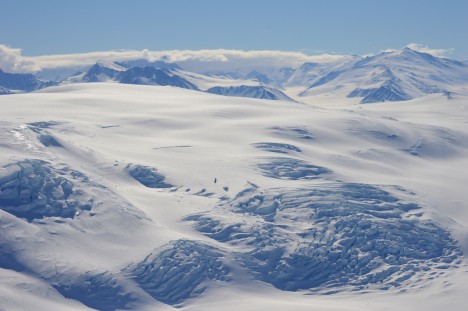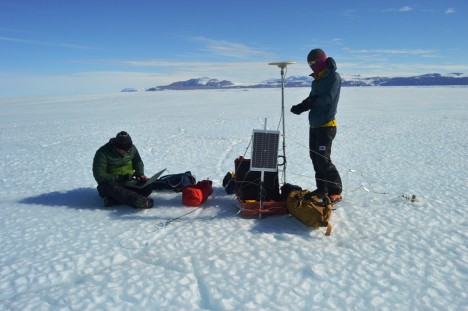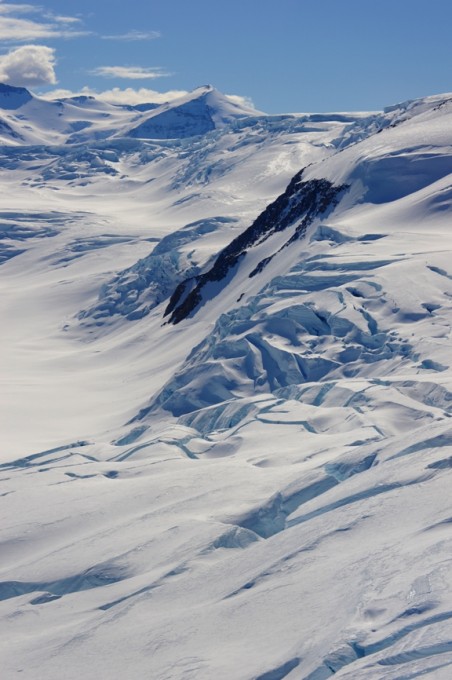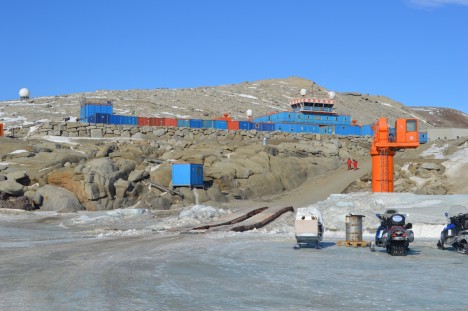

By Christine Dow

Credit: NASA/Christine Dow
The big day had arrived. We were due to fly to our tiltmeters to collect the data that they had been gathering for two weeks. once this was the first time we had ever set these instruments up in the field, all fingers were crossed that we had been precise enough in initially leveling the meters so the data were in range and also that the solar panels hadn’t ended up covered in snow.
We had a spectacular flight, cutting over the end of Priestley Glacier and skirting helicopter-sized crevasses on the mountain behind our field site. Despite a bit of wind on the Nansen ice shelf, it was as calm on the Comein Glacier as it has always been for our visits. It’s such a peaceful, sheltered spot that I feel a holiday cottage wouldn’t be amiss. Perhaps too long of a commute for an average Friday afternoon, however.

Credit: NASA/Christine Dow
One of the tiltmeters (which are in black boxes) had become exposed and, because black materials absorb heat whereas white materials reflect it, had caused a bit of local melt which had trickled down the side of the box and refrozen. The upshot of this was that the entire box, battery, and straps were encased in some pretty solid ice. Fun! Commence some delicate hacking with ice axes so that we didn’t snap the wires coming out of the box. Finally having reached the interior, we nervously extracted the SD card and Ryan pulled the data off onto the computer. Success! Some excellent (and exciting) looking data showing tidal cycles. Tiltmeter two was easier because it hadn’t caused local melt of the snow so we could quickly retrieve the data. Again, some very interesting outputs. We want to thank John Leeman, an engineer from Penn State, for building us some happily working tiltmeters. Of course having disturbed the tiltmeters I had to reset them back to full level, which required sitting for 10 minutes enjoying the view while very delicately adjusting the little leveling legs.
We had just enough time to collect data from one of the GPS closest to the tiltmeters. All looked well apart from our tethers, which had come loose because of melt on the surface. We had one bamboo tether and one metal peg. The metal had heated up and melted a groove in the ice as it was pulled along, whereas the bamboo had stayed where it was supposed to. We tightened the wire as much as possible but we would have to return to this site with some more bamboo later.

Credit: NASA/Christine Dow
Dinner back at base was a happy affair, having achieved success for at least three of seven of our instruments. The chefs had even made some pizza for us, which was a nice treat. The only unfortunate aspect of the day was that I had forgotten that in areas with 24 hour sunshine and highly reflective snow surfaces it is essential to put sunscreen up your nose as well as on it. Burnt nostrils are not fun, but they’re worth it for some nice data.
By Christine Dow
The Nansen Ice Shelf, where we have installed our GPS, is notoriously windy. This is clear from the blue ice on the surface and complete lack of snow, which gets rapidly swept away by katabatic winds (winds driven down from the glacier towards the sea by differences in pressure induced by the cold glacier air). This means that wandering around while setting up the GPS requires spikes for your shoes or else it would be like slipping around on a scalloped ice rink. To prevent the equipment from coming loose and blowing down the ice shelf into the sea, we have a set-up where wire tethers hook our solar panel and GPS box into the ice. However, it’s always encouraging to check that the systems are holding up to the elements, so we took advantage of a helicopter flight heading in that direction to check on the field equipment. It was all still there, happily recording data.
Luckily for myself and Ryan, the flight we were on was heading to the Drygalski Ice Tongue. This is a strange feature that can even be seen when looking at maps of the whole of East Antarctica. It is a floating 12 mile-wide section of ice from David glacier that sticks out 50 miles into the ocean and impacts sea ice freezing and water circulation in the bay behind it. Our approach to the ice tongue was spectacular as it headed off into the distance. At the side of the tongue, steep ice cliffs dropped into the ocean with the interaction between subsurface ice and the ocean water creating the most amazing shade of blue. We could spot groups of Adélie penguins on the remaining sections of sea ice next to the Nansen ice shelf and the Drygalski Ice Tongue.
The most exciting moment was when our sharp-eyed pilot, Dom, spotted some whale spouts. We swung back around and saw four whales swimming around and breaching at the ice margin. They were Arnoux beaked whales, as we later identified, and looked nothing like any whale I have seen before – a little like very large dolphins with long pointed noses. These whales can dive for up to an hour so likely were just having a breather before heading under the ice. This was perhaps my favorite moment of the trip so far.
On the ice tongue we landed to check and download data from GPS stations that our Korean colleagues had installed several years before. We had a great view back across the bay towards Jang Bogo with Mt. Melbourne in the background. The second GPS site was fairly close to the front margin of the ice tongue and so Ryan and I had a geeky moment getting excited about being at the edge of one of the most bizarre ice features in the Antarctic.
It was a great day overall. All our stations were still standing, we saw wildlife, lots of ice and we were even back in time for a noodles and kimchi dinner.
By Christine Dow
Day to day life at the base station is varied primarily by timing of our field expeditions. We’ve had some very busy days getting equipment ready, deploying and checking our gear. In between, however, we are essentially operating as we would do at the office. We have set up base in the ‘Extreme Geophysics Group’ laboratory joining seven Korean scientists. Work tends to happen six days a week, with Sunday as a break (and no 7 am wake-up music!). Also on Sundays there are sometimes mini-expeditions. For example, a group of us walked a couple of miles over to Gondwana, the German base, which is semi-inhabited (two people are there at the moment keeping things ticking over). We were hoping for some “Kaffee und Kuchen” (coffee and cake) but couldn’t find anyone around. Instead we looked at rocks ejected from the nearby volcanic Mt. Melbourne, found some lichen and watched the many skuas (seabirds) flying around. We also ventured down onto the sea ice and found a nice ice slide which entertained us for a while (who said scientists couldn’t be silly).
Last Sunday, Ryan and I joined a short expedition over to Mario Zucchelli, the Italian base. Recently a crack, or lead, has opened up in the sea ice so it’s no longer safe to drive the heavy Piston Bully tractors over. As an alternative, the Koreans and Italians both drove up to the crack and we exchanged passengers by hopping over the gap (it’s not really that big). There were some nearby Weddell seals hanging out near the open water, which we got a good look at. You have to be careful not to get distracted and wander into one of the seal holes which are just a bit darker than the surrounding ice – that would be a chilly surprise!

The Italian base was built 31 years ago so looks a bit more worn in than Jang Bogo but is very cosy inside. We were given a tour and fed some excellent espresso and gelato. It was really interesting to see the differences between the two bases and even the landscape. Despite being only 6 miles (10 km) apart, the rocks around Mario Zucchelli look much more weathered and eroded compared to much rougher terrain at Jang Bogo, perhaps due to the closer proximity of the volcano to the South Korean station.
At Jang Bogo, another big difference is the food and is the subject of much conversation with the Western scientists. There has been a large range of foods produced which keeps things interesting. A lot of it is a surprise since we can’t read the Korean menu, although being able to cope with spicy food is definitely an advantage (Ryan is better with this than I am). By far the best meal was Korean BBQ evening where we cooked meat and prawns on a hotplate right on the table and had a brilliant array of salad leaves (grown in house) and sundries to eat with the meat. What a meal!
By Ryan Walker
Our second day of installing equipment was on November 21. After a cloudy day off, we had perfect sunny weather.
We began by installing our two tilt meters at Comein Glacier, which flows into the Nansen Ice Shelf through a small inlet just north of the much larger Reeves Glacier. Most of an ice shelf floats freely up and down with the ocean tides, and the ice only flexes in a relatively narrow band between the floating ice shelf and the grounded glaciers that flow into the shelf. We chose this location (about 35 miles upstream of the ice shelf front) because the flexure zone is particularly wide (over three miles) and there is a broad strip of over 900 yards of ice that floats at high tide and rests on the ground at low tide. (We know this thanks to satellites that measure the height of the ice surface using lasers or radar, and to comparisons between satellite radar images that detect ice motion.) As it turned out, this area is the most spectacular place we’ve yet visited, surrounded by gleaming white snow- and ice-covered peaks.
Installing tilt meters is rather tricky, since the instrument has to be almost perfectly level. After two Korea Polar Research Institute safety guides checked the area for crevasses (large cracks in the ice), we dug through about two feet of snow before finding solid ice. To keep the tilt meter level, we constructed a table from a piece of plywood supported by three aluminum pipes drilled into the ice. The pipes passed through holes drilled in the plywood, which rested on hose clamps fastened around the pipes. By adjusting the hose clamps, we leveled the plywood before placing the plastic case containing the tilt meter on top of the table. The tilt meter itself has a triangular base with three adjustable screws so it can be leveled on top of a flat plate at the bottom of the case. To do this, I had to attach a cable from the tilt meter to my computer to get readouts of the angles while Christine very carefully adjusted the screws. Once we were satisfied that the instrument was level, we hooked up a solar panel and battery for power, just as we did for the GPS stations. Finally, we buried the case and table in the snow to prevent any melting of the ice supporting the table, which could put the instrument out of level.
After sandwiches and coffee in beautiful sunny weather (certainly the most scenic picnic lunch I’ve ever had), we took some time for a school outreach project that Christine will tell you about. Then we flew back out onto the Nansen Ice Shelf (which is much windier) and installed our two remaining GPS stations with no trouble (other than a chilly half hour waiting for the helicopter to return) to complete a successful day in the field. Now we need to wait about two weeks before collecting data, so that we can see what happens to the shelf as the ocean tides go through a full cycle from spring (largest difference between high and low tide) to neap (lowest difference).
Christine says: I’m involved in a program coordinated by the United Kingdom Polar Network called “The Antarctica Day Flags Initiative”. School classes design flags for Antarctica Day (which is December 1, the anniversary of the signing of the Antarctic Treaty in 1959) and then scientists and researchers take them to the Antarctic and take photos of them out in the field. I had 21 flags from two schools (Yardley Hastings and Northrepps Primary) so we attached these to poles and took some pictures in front of some beautiful icy cliffs with our Korean colleagues.
By Brian Walker
November 19th — After the final cargo flight on November 17th, we finally had all our equipment and could prepare for installation. This wasn’t without some drama, as we initially received only four batteries and various pipes, but none of the actual instruments. After a few tense hours of emailing, we found that the rest of our gear had accidentally been sent to the Italian Mario Zucchelli Station, so we would be fine. (Zucchelli and Jang Bogo are within sight of each other, about six miles apart on opposite sides of a bay which is currently frozen over, so the Italians and Koreans share flights.) Christine joined a group taking a tractor drive over to Zucchelli the next day and retrieved the misplaced equipment. After a long day of testing our GPS units outside in high winds and organizing the equipment in a slightly cramped laboratory building, we were ready to go the next morning.
We were fortunate to begin the day with good weather, and due to a slow schedule, we had both helicopters. This allowed four Korea Polar Research Institute (KOPRI) personnel, including a safety guide, to join us. With their help, we were able to install the GPS stations much more quickly (sometimes in as little as half an hour) than we would have been able to manage by ourselves.
Our GPS systems include a disk-shaped antenna that receives satellite signals and a computerized unit that processes and records data. With good processing after the stations are retrieved, we should get positions accurate to about half an inch, which will allow us to study the vertical and horizontal motion of the ice shelf, especially the effect of ocean tides. The stations also include a solar panel and a 12-volt battery (essentially a car battery) for power. To install a station, we wire the receiver (the computer), which stays inside a weatherproof plastic box the size of a carry-on suitcase, to the antenna, solar panel, and battery. The antenna is mounted about five feet off the ground on the end of an eight-foot steel pole sunk into a three-foot drilled hole. The solar panel is mounted on a shorter pole that also passes through the carrying handle of the plastic receiver box, so that it’s much harder for the receiver to blow away — a constant threat with a slippery ice surface and high winds. Wires attached to anchors drilled into the ice secure the solar panel, and the battery is firmly strapped to the receiver box. Where necessary, we used ice axes to chop roughly six-inch deep holes for the receiver box and battery to rest in. For the poles and anchors, the final step was to pour water into their holes, which instantly froze and locked them into place.
We had planned on installing two GPS stations, then returning to Jang Bogo to reload the helicopters and installing the remaining three in the afternoon. However, heavy cloud cover started to blow in as we installed the first station of the afternoon. Clouds diffuse sunlight and create an effect called “flat light”, in which depth perception of white snow and ice surfaces becomes difficult. This obviously isn’t good for flying helicopters, so we returned to the station early to be safe. It was still a good day, with three GPS stations successfully installed. Two GPS stations and two tilt meters remain to be installed when weather and flight schedules permit.